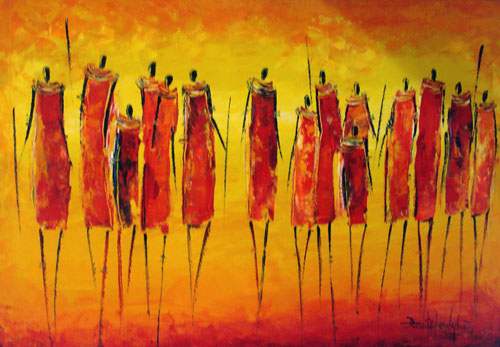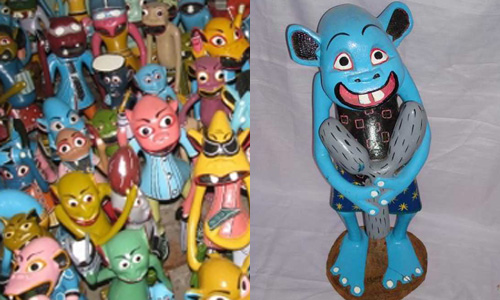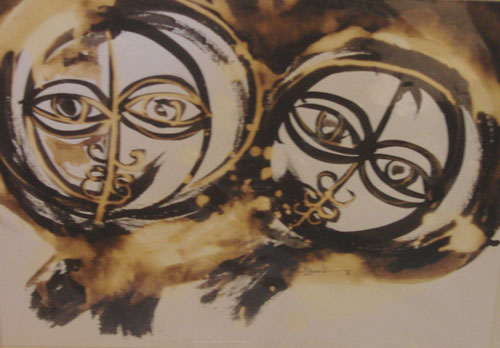It was an odd feeling going on my first-ever safari during my recent trip to Tanzania. Odd because even though I had never been on one, I already had a fairly well-formed idea — a fantasy really — as to what that experience would be like. Mine was a vision shaped since I was young by countless popular cultural sources. Everything from Looney Toons cartoons, to movies, to nature shows on cable (as well as early black and white Tarzan shows on Saturday morning TV, I suspect) played a part in this imaginary construct. Going into my trip, it is safe to say that I had a certain fantasy conception of “African safari,” and I’m happy to report that the actual experience not only matched that vision, but far exceeded it.
It was an equally odd feeling finally going on this trip to Tanzania because of my intention of getting a sense of the local contemporary art scene — odd because my vision of what such contemporary art might look like was decidedly unformed going in. Mine was a journey that began in the lively town of Arusha, in the western part of Tanzania not far from Mount Kilimanjaro. One of the first and lasting lessons learned there was that the contemporary scene — and this would be the case elsewhere in Tanzania — can be somewhat difficult to identify, as the line between a glorified curio shop and a dedicated art space can become quite blurred, with works better suited in one too often found in the other.
One of the paintings that proved remarkable to me during my time in Arusha was a decidedly ordinary canvas. The composition consisted of several long, attenuated figures repeated horizontally across the surface and rendered in rich colors and lively brushwork. These slender forms, abstracted to little more than a handful of lines and a few splashes of color, were warriors of the Maasai tribe, which is found throughout Kenya and Tanzania. This canvas would have been entirely unremarkable were it not for the fact that a few hours later I happened into a different galley in another section of Arusha, where my eye was drawn to a canvas containing the same rhythmic repetition of attenuated Maasai figures as the one before, hand-rendered and with nearly identical sinuous lines and color. At the time I could not know that I would see this composition, with surprisingly little variation, nearly everywhere I went on my travels across Tanzania. I found it in a small art shop in a coastal town a few hours north of Dar es Salaam, on a side street in the sprawling city of Dar itself, and again in Stone Town, a port town on the island of Zanzibar.
Once I came to terms with this strange repetition of the hand-painted Maasai canvas, I could not help but read them collectively as an ironic, contemporary sign of the durable legacy of the modernist celebration of the primitive and the naïve. According to this timeworn modernist logic, the African artist was defined as such by a use of authentic tribal colors and forms and by an absence of Western artistic and cultural pretension. Of course, these purported signs of the authentic, redoubled by expressive brushwork (itself thought to be an index of immanence and self-reference) trace back to the very qualities and ideals of a Western conception of artistic value.
I rehearse this modernist fantasy of “exotic” art because it is precisely these marks of authenticity that I found repeated again and again on my journey through Tanzania. With each encounter these otherwise totally forgettable hand-painted canvases of the Maasai progressively functioned not as a vivid representation of natural Africa and some intuitive technique of the African artist at the end of the brush, but as a sign of a mass production keyed to a desire for such qualities in African art.
The canvases and their amazing ubiquity became an index of that enduring modernist fantasy, a fantasy that has become the work’s content. As a representation not of Africa or African art, but of a certain fantasy conception of Africa and African art, the painting that reappeared throughout my trip gestures to a fantasy whose desires it fulfills and whose aspirations it answers. In the repetition of abstract forms and rich colors (meant to evoke the look and feel of Maasai standing in the distance and set against a vast African plain), Africa has become inscribed in the work as idea — as image — and with each iteration, the distinctive lines and splashes of color become the mark of the icon.
All of this is not to say that I didn’t come across artwork that I liked in the course of my travels. To the contrary, while I was admittedly preoccupied with my “where’s Waldo?” search for the iconic Maasai painting, I nevertheless found several artists whose work I enjoyed, and I will conclude by mentioning two of them. The first is George Lilanga, who was born in Kikwetu, a village in southern Tanzania and lived in Dar es Salaam until his death in 2005. Lilanga, who achieved some international success during his lifetime, is best known for his paintings and sculptures of fantastic, cartoon-like humanoids.
Lilanga’s whimsical, diminuitive figures — each featuring only a few fingers and toes, outsized ears, and exaggerated protruding lips reminiscent of the lip plugs used by Makonde women — represent entities from the spirit world of the artist’s Makonde ancestry. Lilanga’s little spirits call to mind both Keith Haring’s colorful forms and Matt Groening’s Simpsons characters from their early days on The Tracey Ullman Show. In fact, Lilanga’s work — a blend of vernacular references and witty forms — actually predates that of both Haring and Groening, and is even reported to have influenced Haring.
Jjuuko Hood is another artist whose work I discovered while in Tanzania. Hood is a recent graduate of the well-respected art program at Kampala University in Uganda. His captivating canvases blend dynamic, textured surfaces, innovative materials (at present he is using acrylics on bark cloth, which is produced from Ugandan fig trees), with themes steeped in local cultural references. Hood’s work demonstrates an appreciation of certain modern European art movements — cubism foremost among them — yet to my mind, he successfully avoids becoming derivative. Would it be odd to say that, unlike those Maasai warrior canvases, the work by Jjuuko Hood and George Lilanga fulfilled my own fantasy conception of what contemporary African art should be?







